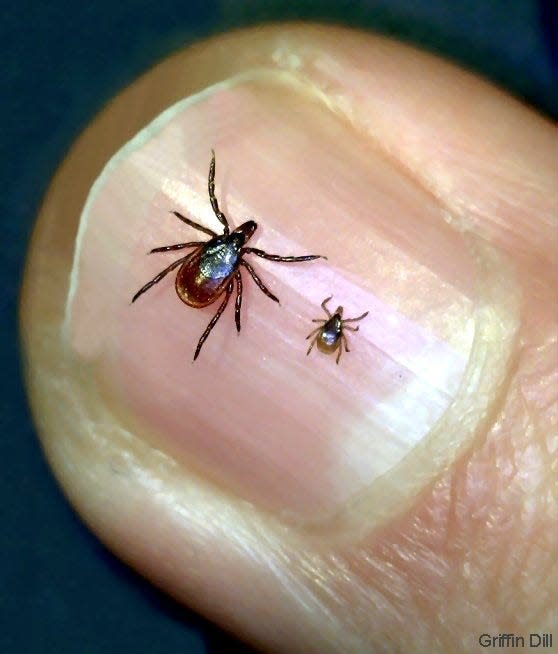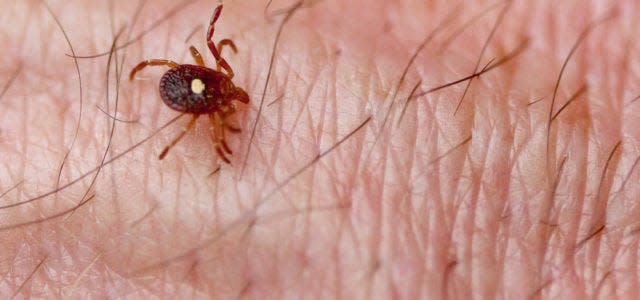Ticked off: Ticks may pose increased threat to humans, animals in Ohio this year
Spring and summer are often synonymous with the emergence of ticks, but just how bad is the infestation of the little parasites this year?
Well, it depends who you ask.
Ohio State University's College of Food, Agricultural and Environmental Sciences is warning Ohioans to expect more ticks in the state as temperatures rise. Tim McDermott, an educator with the college's outreach program, said the increase may be attributed to climate change and the human development of tick habitats.
"Ticks are extraordinarily adaptable and can travel on host animals," McDermott said in a prepared statement. "They take advantage of what they can take advantage of to move to new spaces. So now, every year going forward has the potential to be bad, and you should go into each tick season thinking about how you can keep you and your family tick-safe."

What's the tick situation in Stark County?
Though experts agree the warning is warranted, health professionals in Stark County have yet to see anything out of the ordinary.
Richard Wade, veterinarian and owner of the Canton Veterinary Hospital, 3123 Cleveland Ave. NW, said his clinic normally experiences two yearly spikes in tick-related pet visits — one in April and one in October. Though he has seen a lot of ticks this year, he said it's not exactly more than past years.
Phil Revlock, program manager at the Stark County Health Department, said the department has received a normal amount of tick-related calls this year. No matter the amount of ticks, he said, the most the agency can do is educate people on ticks and identify the species that people bring in.
Ticks are threats to pets
One of a tick's favorite ways to transport and feed itself is by embedding in the skin of animals, including house pets. Wade said he primarily sees ticks on dogs more than any other animals, mostly because cats are better at cleaning themselves and are more likely to live exclusively indoors.
Brian Allerding, a veterinarian at the North Canton Veterinary Clinic, 1227 N. Main St., said ticks can subject pets to a variety of illnesses, most commonly Lyme disease.
Allerding said a lot of the pets he sees that have been exposed to Lyme disease tend to be asymptomatic. Wade said symptoms can vary from a low grade fever and dullness to major liver disease. Additionally, Wade said, ticks on pets can present problems to their human counterparts.
"If your pets have ticks, you could potentially get ticks yourself," Wade said. "So, for people that have their animals and they're picking ticks off of them, make sure that the kids are checked out by the parents [to ensure] that they don't have ticks on them."
Threats to humans
Exposure to ticks and tick-borne illnesses can pose extreme threats to humans.
Bill Robinson, the environmental director for the Alliance City Health Department, said Lyme disease and Rocky Mountain spotted fever are the two most common tick-related diseases he has seen. Both diseases can cause headaches, fatigue and vomiting, as well as more serious conditions if they are left untreated.
Revlock said the blacklegged tick, also known as the deer tick, is the only one with the ability to transmit Lyme disease. However, that's not to say other ticks aren't dangerous. The bite of a Lone Star tick, which can be found in Ohio, may cause people to develop an allergy to red meat.
Learn about the Lone Star tick: This tick's bite can cause an allergy to red meat, and it's found in Ohio. Here's what to know.

Best practices for prevention
Though ticks can cause several problems, there are multiple ways in which one can keep their pets, their loved ones and themselves safe.
Robinson recommended that people check themselves for ticks each time they come indoors. If one is found, he said, carefully remove it with tweezers, making sure to get as close to the head as possible and pull straight out.
Revlock said that one of the easiest ways to avoid ticks is to try to avoid their habitat in general, though that is increasingly difficult as more housing developments eat up grassy, tree-dense areas.
"As long as you don't go where the ticks are, you can stay away from them," Revlock said. "Ticks don't fly or jump. They're actually just on the vegetation. You actually have to be in the vegetation and bump, high weeds, high grass, the trees, what have you. So if you stay out of their area, there's really going to be no chance unless your dog runs loose or something."
Both Allerding and Wade said the best way to protect pets is by preventing ticks from even getting on the animals. That can be done with pills, topical treatments and flea and tick collars, among other methods.
Reach Ryan via email at rmaxin@gannett.com, on Twitter at @ryanmaxin or by phone at 330-580-8412
More disease prevention methods
Looking to avoid ticks? Here are some tips:
Tuck in your shirt to your pants and your pants into your socks
Wear light colored clothing to make it easier to spot ticks
Use bug/tick repellant
Do not allow pets to venture into wooded or grassy areas, if possible
Wash tick bites thoroughly with soap and warm water
Research who can identify ticks in your area and have ticks identified if found
Seek medical attention if you suspect you have been bitten by a tick and start to develop flu-like symptoms
SOURCE: Ohio State University, staff research
This article originally appeared on The Repository: Be weary of possible increase of ticks, illnesses in Ohio this year

